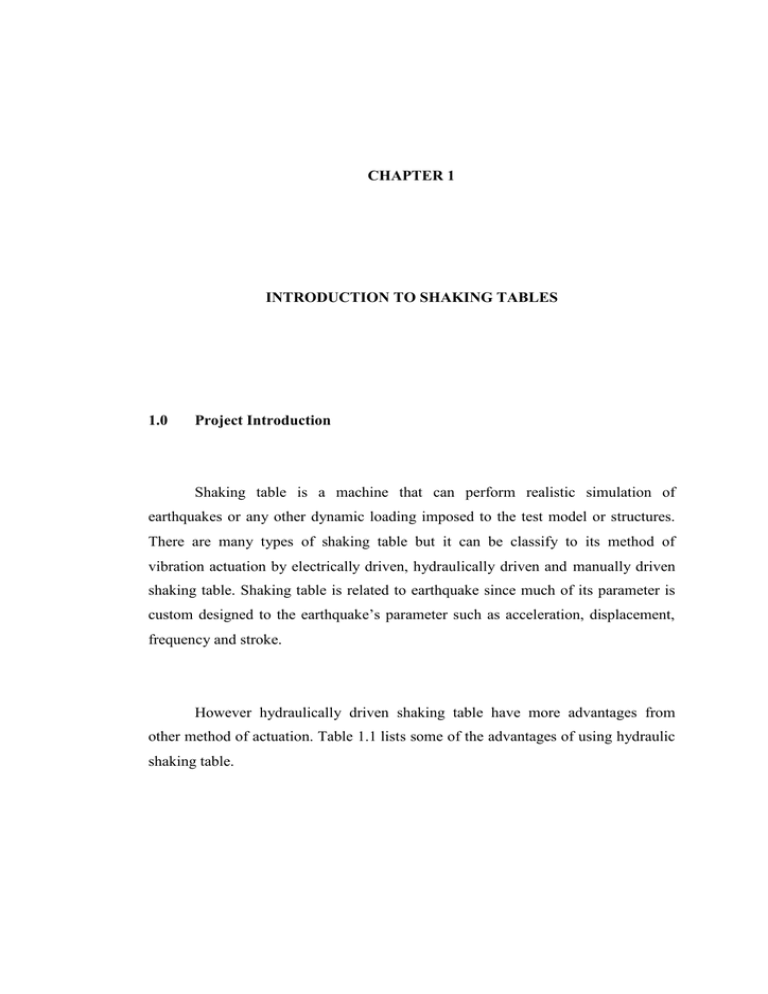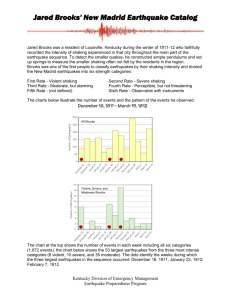CHAPTER 1 INTRODUCTION TO SHAKING TABLES 1.0 Project
advertisement

CHAPTER 1 INTRODUCTION TO SHAKING TABLES 1.0 Project Introduction Shaking table is a machine that can perform realistic simulation of earthquakes or any other dynamic loading imposed to the test model or structures. There are many types of shaking table but it can be classify to its method of vibration actuation by electrically driven, hydraulically driven and manually driven shaking table. Shaking table is related to earthquake since much of its parameter is custom designed to the earthquake’s parameter such as acceleration, displacement, frequency and stroke. However hydraulically driven shaking table have more advantages from other method of actuation. Table 1.1 lists some of the advantages of using hydraulic shaking table. 2 Table 1.1: Comparison of hydraulic and electric shaking table Hydraulic shaking table 1. Can be used for any size of load Electric shaking table 1. Limited to small and medium size load. 2. Some of the parameter such as stroke, velocity, frequency can be changed 2. Most of the time , the parameter have been set cannot be changed. easily depend on application. 1.1 Objectives of Study The main objectives of this study are: 1. To design a medium hydraulically driven shaking table to be used as an earthquake simulator. 2. To perform simulation of the designed hydraulic shaking table using techniques of dynamic system analysis especially in time domain method to investigate the linearity characteristics between input signal and the desired output. 3 1.2 Scope of Study The scope of this study are: 1. Investigate the nature and properties of earthquake and its relation to the parameter to be used in the design of hydraulic shaking table. 2. Design a complete hydraulic circuit of a medium scale simple hydraulic shaking table based on selected parameter. 3. Derive the dynamic equation of the hydraulic shaking system and develop a mathematical model for the overall system. 4. Select a proper practical value for each parameter assigned in the mathematical model. 5. Perform computer simulation using MATLAB Simulink on the time domain analysis, feedback system design and to check the stability of the overall system. 6. All simulations are performed within the limitation of the selected parameter such as maximum load range, frequency range, shaking axis and maximum acceleration range. In this project, the works are bounded in the frequency range of 20 Hz, maximum acceleration of 1.5g and maximum load of 4330 kg. Main component of hydraulic circuit and the hydraulic circuit diagrams have been designed and discussed. Mathematical modeling of this project is being done on the servovalve and hydraulic servomechanism using Laplace Transform. Separate modeling will be 4 done that is modeling of servovalve and modeling of actuator mechanism. Not only that due to nonlinearities in the servovalve, it is better to do a separate modeling of servovalve so that proper steps can be applied in order to take care of the nonlinearities. Then the modeling will be combined using block diagram and can be programmed in the Simulink. Simulation part will be done in Semester II and the program that will be used is MATLAB Simulink. In this program the overall block diagram will be programmed in it and input signal will be imposed on the block diagram. Types of input signal to be tested are Step, Sinusoidal and Random input signals. Simulation also being done separately that is simulation of servovalve and combined simulation of servovalve and actuator to investigate the individual response. A proposed controller will be added. Then it will be compared and tested against disturbance effect on the system. Finally, the controller that fulfills the performance and robustness specifications will be selected. In the simulation, some design limitation and outcomes will be investigated in order to compensate for any practical changes that might occur during the actual condition. This project is important to get the preliminary design of hydraulic shaking table of medium scale that have many benefit to the future work and development of this machine. Future research in this field is interesting since it can develop more realistic design of hydraulic shaking table. 5 1.3 Operation of Shaking Tables Shaking table is a mechanical device that is used to test any structures under seismic or other types of dynamic loading such as step load, sinusoidal varying force, or random load. If the shaking table is designed primarily to test civil structure under seismic loading, then it is also called earthquake simulator. Normally test model are developed to understand the effects of different parameters and process that leads to failure of prototype at a real time. If the test model are performed under gravitational field of earth, then it is subjected to the shaking table test, whereas if the model tests are performed under higher gravitational field then it is subjected to centrifugal test. Therefore shaking table test is an experimental approach in order to assure the validity of the theoretical estimation of the response of the structure with the exact dynamic characteristics thus to develop the safety margin of design for the structure. In the shaking table test, test specimens are placed on the table and it is fixed by mechanical fastener or artificial soil compacted on the table. Then the structure will experience a shaking process at a certain frequency values until a certain time limit set by the operator. The earthquake simulator or shaking table has a wide range of applications such as: Models of buildings or structure in a given scale, subjected to actual earthquake. Models of power supply or industrial buildings under specific dynamic loading conditions. Mechanical equipment and transportation facilities test Mechanical testing and development of dampers for power transmission lines. 6 Shaking table device operates in various means. Some of them use allelectric servo motor driven type as in Figure 1.1, servo hydraulic means of actuation for high mass payloads such as in Figure 1.2 and manually operated shaking table as in Figure 1.3 that use external applied force to shake the table. Figure 1.1: Electric shaking table [1] Figure 1.2: Servo hydraulic table [1] Figure 1.3: Manual shaking table [2] 7 1.4 Types of hydraulic shaking table Since most of the shaking table is used as an earthquake simulator purposes, there is some of them been used as an apparatus to test the response or frequency of a structure or a test model. This permits the versatility and wide range of shaking table model. Shaking table is grouped based on its actuator power, frequency range and the maximum load it can handle. Normally it is classified either in small scale, medium scale or a large scale load. Small scale load hydraulic shaking table ranging from 0 to 1000 kg load whereas for medium scale can range from 1000 to 5000 kg and large scale range is greater than 5000 kg load. Section 1.4.1, 1.4.2 and 1.4.3 shows some manufacturer of hydraulic shaking table in the market. 1.4.1 INOVA – Servo hydraulic Testing System INOVA is one of the leaders in seismic simulations for earthquake and structural research. Their seismic simulator called “Seismic Shaking Table” is used for seismic qualification and seismic simulation in civil engineering and academic research into earthquake. INOVA’s seismic shaking tables are designed for earthquake testing of a wide range of test applications. INOVA systems can be used to simulate a variety of seismic tests as well as evaluating many different types of components in vibration and shaking environments. The DOF refers to the number of shaking axis the machine can apply to the test model. Typical configurations are one, two, three and six degrees of freedom (DOF) as in Figure 1.4, 1.5 and 1.6. 8 Figure 1.4: 6 DOF shaking system [3] Figure 1.5: 3 DOF shaking system [3] Figure 1.6: 1 DOF shaking system [3] The six degrees of freedom hydraulic shaking table machine is intended for general-purpose vibration tests. It is classified as a large-scale machine .In this machine, test model can be loaded in one axis or simultaneous axes. Test can be run in constant amplitude, block program or full simulation with combination of more than one wave profiles to be simulated simultaneously. 9 1.4.2 ANCO-Model R150.142 shaking table This servo-hydraulic type-shaking table was used by Columbia University. It is a medium scale shaking table facility to conduct experimentation in structural dynamics and particularly to monitor and actively control structures subjected to earthquake ground motion or other force excitations. The table which was custom designed by ANCO Engineers for the Civil and Structural Research Engineering capable of carrying maximum three ton payload on the 5ft x 5 ft table size. The table is able to shake two ton payload with 3g acceleration (three times the acceleration of gravity in horizontal direction). Thus the table is ideally suited to seismic application. The hydraulic actuator can produce a stroke of maximum 10 inch (± 5 inch). The actuator has a three-stage servo-valve controlled by an analog inner-loop control system and a digital outer loop control system (acceleration feedback based). Figure 1.7: Close up of the 22 kip actuator with 3 stage servo valve [1] 10 Specifications of ANCO-Model R150.142; 1. Shaking direction : Uni-axial horizontal motion 2. Table size : 5 ft x 5 ft. 3. Peak to peak displacement : 10 inches of double amplitude 4. Peak velocity : 60 inch / sec. 5. Peak acceleration : 3.0g 6. Maximum test specimen weight : 2 tonne 7. Frequency range : 0 – 100 Hz. 8. Servo valve : 3-stage electrohydraulic servovalve. 1.4.3 NIED-E Defense Facility in Japan Recently due to a number of major damage caused by earthquakes and structural buildings failure cases in Japan have led to the start of NIED-E Defense project. National Research Institute for Earth Science and Disaster Prevention (NIED) have three main objectives that are to conduct research and experimentation on the structural building failure test, developing three dimensional motion of the simulated real earthquake from past record earthquake data and build full scale model to predict the real behavior of the damage. NIED use a big scale shaking table facility as in Figure 1.8 to test their ready-made full-scale model. Some of the specifications of the shaking table facilities are; Shaking table type : 3D Full scale earthquake testing facility Payload : 1200 ton Shaking table size : 20m x 15m 11 Driving type : Accumulator charge, Electro-hydraulic Servo control Shaking direction : X and Y Horizontal, Z – Vertical Maximum acceleration at maximum loading. : X, Y Horizontal is > 900 cm/s2 Z-Vertical is >1500 cm/s2 Maximum displacement : X, Y Horizontal is ±100 cm Z-Vertical is ±50 cm Figure 1.8: NIED earthquake simulator from Japan [4] 12 1.4 Project Scheduling This project will be done within two semesters. Thus, breakdown of work structures must be implemented to make sure all the work being done within its allocated time. In the first Semester, initial literature research work will be done. This is to get a better picture on how to implement the scope of study number one until three. In Semester two, scope of study number four until six was performed. The breakdown of work structures for Semester one and two are attached in the Appendix A.




